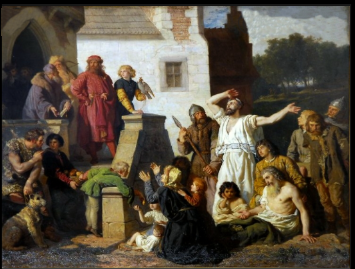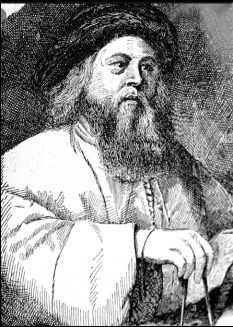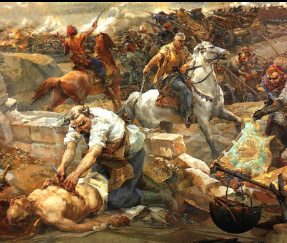And of course, we have the age-old Jewish part of the story,
but with an ironic twist. In that the "hero" and leader of the nation
of the story involved is Volodymyr Zelensky a "native born " Jew.
Yet, Zelensky is NOT the first "court Jew", whilst in
our long diaspora several Jews have achieved a place of prominence in the lands
we have settled in. There have been several Jews who have achieved-been
appointed or been elected to "high office".
What is happening of course is an immense tragedy of human
suffering that is caused by festering hatreds based on historical differences
between peoples. These same areas that were latter termed the "Pale of
Settlement" have been an area contested and vied for centuries between the
Germanic tribes and those who would become the Polish people and the Russians.
The area of the Ukraine is a vast burial ground of millions of Jews who were butchered and murdered by the Einsatzgruppen of the Nazis and their over eager local collaborators. The very presence of local Jews was totally erased from their villages during the "Holocaust" with the overly enthusiastic participation of many "fellow Ukrainians". Who out of fear in late 1943-1944 together with the Nazi's brought Sonderkommandos; work units made up of Jewish death camp prisoners to exhume the bodies of the victims of the executions.
“We used to uncover the graves where there were people who had been killed during the past three years, take out the bodies, pile them up in tiers and burn these bodies, grind the bones, take out the valuables in the ashes, such as gold teeth, rings and so on, and separate them. After grinding the bones, we would throw the ashes up in the air so that they would disappear, replace the earth over the graves, and plant seeds so that nobody could recognize that there was once a grave there."
What IS different, THIS TIME. is that these Jews fleeing the hell of war are seeing the flag with the two blue stripes and the star of David flying on the borders symbolizing a place to flee to OUR homeland and freedom!! They see our representatives sent to shepherd them to life in OUR INDIGENOUS HOMELAND!!
Our enemies, the those ever so sad descendants of the
self-inflicted tragedy of their ignomius defeat in 1948 whom I call the "Tragedy
Tourists of Nachbaland™" and their overly enthusiastic minion of
anti-Semite followers are once more frustrated and full of sick vile vulgar
hatred once more!
Only this time they cannot refuse our people, who in dire
need to flee death DO have the doors open to our homeland.
The long history of the Jews and the Ukraine
Many of the descendants of Jews in Europe are according to DNA studies descendants of the more than 100,000+ Jewish male and some female slaves sent to work the marble mines of Northern Italy with Vespasian's defeat of the "First" Jewish Revolt in 73CE.
Eastern Ukraine was home to the Khazar empire, a kingdom of
Turkic people that arose in southeastern Russia in the 6th Century CE and
extended as far west as Kiev, the capital of present-day Ukraine.
It is said that in the 8th Century, that the area was ruled
by a semi-divine king called a Khagan, and local chieftains called “Begs”.
Legend says that the Khazar king at that time invited representatives from the
three monotheistic faiths to his palace and listened to each of them discuss
their religion. It is said that the Khazar king was so struck with Judaism’s
beauty and lucidity that he converted to Judaism and ordered that his followers
do so as well. According to this story many Khazars became Jewish, embracing
Jewish holidays and Shabbat and keeping kosher.
In the early Middle Ages, the largely Jewish kingdom of the Khazars was buffeted by invading Russian forces, which ransacked its capital city in about the year 965 CE. The end of the Khazar kingdom came in the 1200s, when Mongol tribes invaded much of present-day Ukraine and Poland, causing huge devastation and loss of life.
In order to build back its power and wealth, Poland invited new residents to move into its territories from the west, primarily from Germanic lands. The Middle Ages were indeed a tumultuous time in Ukraine. Accounts describe the city of Kiev as being home to a substantial Jewish community in the 11th and 12th centuries. There were two heavily Jewish suburbs of the city, and one entryway into Kiev’s city walls that was known as the “Jewish Gate”. There are also references to a Jewish scholar at the time known as Moshe ben Yaakov of Kiev.Poland’s invitation for immigrants to come attracted Jews
who were fleeing massacres in central Europe in the wake of the Crusades and
the Black Death. Jews settled throughout Poland, including in territories that
form present-day Ukraine, most notably the region of Volhynia, which lies at
the intersection of Poland, Belarus and Ukraine. By the 1400s, up to 30,000 Jews
were thought to be living in 60 different communities across Ukraine, including
in the present-day capital city, Kiev.
Hasidim and the Ukraine
Rabbi Dov Ber, also known as the Maggid (preacher) of
Mezeritch (1704-1772), first consulted with the Baal Shem Tov when he was ill.
The Baal Shem Tov was known as a healer, as well as a religious sage. Rabbi Dov
Ber was so impressed that he adopted the Baal Shem Tov’s worldview, which
emphasized worshiping God with joy. Within a generation, Ukraine was home to
some of the most important and influential Hasidic masters, including Rabbi
Levi Yitzchak of Berditchev and Menachem Nachum (and his son Modechai Twersky)
of Chernobil. Ukrainian Jewish communities embraced Hasidic Judaism, with its
emphasis on rigorously religious practice combined with spirituality and an
emphasis on infusing religious observance with joy.
Perhaps the greatest Hasidic rabbi in Ukraine was Rabbi
Nahman, from the Ukrainian town of Breslov (1772-1811), a great grandson of the
Baal Shem Tov and a direct descendent of the Maharal, one of Europe’s greatest
rabbis who lived in 16th century Prague. Rabbi Nahman built a large community
in the Ukrainian town of Zlapotol in the early 1800s. He taught that Jews
should strive to feel close to God at all times, and that feeling happy is best
way to appreciate all of God’s many blessings.
The Ukrainian town of Uman, about 125 miles south of Kiev,
is where Rabbi Nachman of Breslov lived during his final years and is buried.
Uman has emerged as a major pilgrimage site for thousands of Jews each year.
The most popular time to go is Rosh Hashanah, when tens of thousands of Jews
visit Uman to celebrate the holiday together in the place where Rabbi Nahman
taught.
The Cossacks and the Chmielnicki Massacres
Between 1648 and 1651, Chmielnicki’s followers killed about
20,000 Jews with unimaginable barbarity. Approximately half of all Jews living
in Ukraine fled. So great was the Cossacks’’ depravity that some terrified Jews
even fled into Crimea, where they faced slavery in the hands of Muslim Tatars.
The official records of the Jewish community in Kiev recorded the beginning of the massacres:
"Immediately after the death of the pious King Wladyslaw (1648) tens of thousands of villains, among them Cossacks…went forth and committed manu murders in the holy communities of Niemirow, Tulczyn, Machnowka, and other hold communities who congregated in order to save their lives from the…sword… Since the destruction of the Temple no other cruel murder like this one was committed for the sanctification of the name” of God."
Another eyewitness account described:
“they massacred about 6,000 souls in the town…and they drowned several hundreds in the water and by all kinds of cruel torments. In the synagogue, before the Holy Ark, they slaughtered with butchers’ knives…after which they destroyed the synagogue and took out all the Torah books…they tore them up…and they laid them out…for men and animals to trample on…they also made sandals of them…and several other garments.” The Cossacks knew no bounds in their sadism and cruelty and attacked and killed Jews – as well as some Polish nobles – with horrific barbarity."
Chmielnicki appealed for military aid from Russia and in
1654 much of Cossack-controlled Ukraine became a client state of Russia.
Sporadic pogroms continued through the years, most notably in the city of Uman
in 1768.
Ukrainians blamed Jews for their landlords’ greed.
Jewish life in present-day Ukraine became even more
entrenched after 1569, when much of present-day Ukraine came under a new
political alliance, the Polish-Lithuanian Commonwealth.
Ukraine was an uneasy mix of many different ethnic groups.
Much of the farmland and industry in Ukraine was the property of Polish nobles
who were Catholic. The peasants in Ukraine were a mix of Eastern Orthodox
Ukrainians and groups known as Cossacks, who lived primarily in the southern
part of Ukraine. In the far south, the Crimean Peninsula was owned by the
Ottoman Empire and populated largely by Tatar Muslims, who engaged in constant,
low level warfare with Cossacks along their border. Both groups would stage skirmishes
into each other’s territories, seizing property and slaves.
With many farms and businesses owned by absentee Polish
landlords and nobles, an exploitative system called "Arenda"
developed, which allowed agents to manage farms and other enterprises on behalf
of absent landlords. It was often Jews who were employed to manage the "Arenda
economy", acting as caretakers for absentee nobles and landowners. Jews
managed salt mines, farms, mills, and inns. They also became local tax
collectors for Polish noblemen. Many "Arendas" were given out in the
alcohol trade: brewing, selling alcohol and managing inns and taverns were
often seen as Jewish professions.
Working for hated landlords put Jews in an impossible
position: they needed the "Arenda" system in order to survive
economically, but the local peasants blamed Jews for their employers’ increasingly
abusive practices. When Polish nobles increased taxes on their already
suffering tenants, it was their Jewish agents who bore the blame. In time,
extreme antisemitism became engrained in much of Ukrainian culture.
The term “pogrom” was invented after riots in Ukraine.
In 1881, Czar Alexander II was murdered by a left-wing
terrorist. Soon, it was being (incorrectly) reported across Russia that the new
Czar Alexander III had ordered Russian subjects to kill Jews. Pogroms broke
out, with the greatest number taking place in Ukraine. These weren’t the first
massacres of Jews in Ukraine and elsewhere in the Pale of Settlement, but the
frequency and intensity of the mob attacks resulted in the phenomenon being
given a new name: pogrom, which means violence in Russian.
Pogroms continued throughout the end of the 19th century.
Some of the most horrible pogroms took place in 1905, after Czar Nicholas II
issued the October Manifesto, guaranteeing all Russian subjects some basic
political rights. The manifesto came at a perilous time in Russian politics,
with political rivals ready to attack each other. As violence broke out, mobs
turned on the Jews in their midst. Some of the worst anti-Jewish attacks were
in the Ukrainian city of Odessa: The Jewish newspaper Voskhod reported that
over 800 Jews were murdered in pogroms in Odessa in the days following the
October Manifesto, and several thousands more were wounded.
Sholem Aleichem’s daughter later described the moment they
realized their lives were in danger: “We ran from our beds to the windows on
the street and looked down on the scene of brutality and murder – a gang of
hoodlums beating a poor young Jew with heavy sticks; blood was running over the
face of the young man, who was vainly shrieking for aid. A policeman stood
nearby, casually looking on and not moving a finger.”
After the Kiev pogrom, Sholem Aleichem’s entire family fled
Ukraine, eventually settling in New York.
The Russian Revolution in 1917, the Polish Ukrainian War of 1918-1919, the Ukrainian War of Independence, and the Soviet-Polish War of 1919-1921 sparked waves of hundreds of pogroms across the region which killed approximately 100,000 Jews. (Ukraine was briefly independent, before being divided by Poland and Russia.)
The violence was unspeakably intense. In the Ukrainian town
of Proskurov, for instance, a three-day pogrom that broke out on February 15,
1919 killed 1,500 Jews. The town of Pogrebinschi experienced two pogroms: in
May, 1919 Soviet troops went on a murderous rampage, killing 400 Jews. Three
months later, Ukrainian nationalists staged a second pogrom and murdered a
further 350 Jews there. Over 1,300 towns became scenes of horrific violence
towards Jews.























